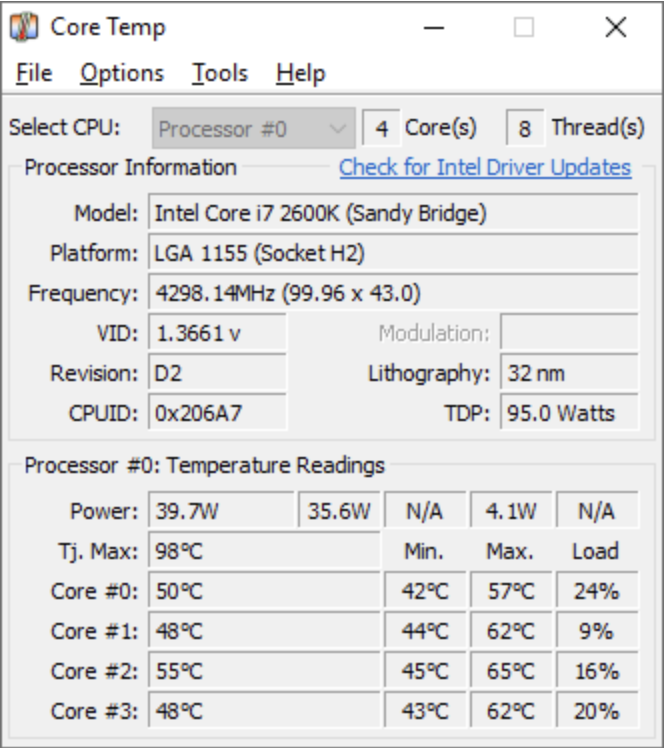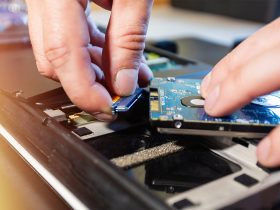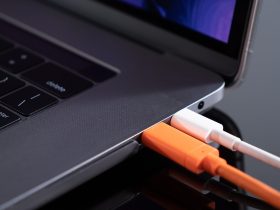If your computer or laptop keeps getting too hot, it’s most likely to have the technical version of a headache: Its Central Processing Unit (CPU) or “brain” has overheated. This can cause many problems, including permanent damage to internal components and your files being lost for good. Don’t panic—our specialized cleanup software will help you keep your cool. It can free your computer from any digital junk that’s weighing it down and helps prevent overheating and stuttering performance.
Is your PC really overheating? Take its temperature.
PCs and devices don’t like being too hot. Much like humans, it can make them perform more slowly or shut down altogether. Perhaps you’ll hear the fans spinning madly and your device may be hot to the touch. If this tends to happen during intense tasks like gaming, then overheating is most likely the culprit behind your problems. That’s why it’s a good idea to keep an eye on the internal temperature of your machine. Rather oddly, Windows doesn’t let you easily check your computer’s CPU—not unless you want to take a deep and rather complicated dive into the system BIOS. Thankfully, there are several free heat-monitoring programs that promise a simpler user experience.
Core Temp tends to be a popular choice (but keep an eye on where you tick during the setup as, like many freebies, it may try and include bloatware. There’s also a Core Temp app for Android devices feeling the heat). Here’s how to check the temperature of your central processor with Core Temp:
- Download and install Core Temp.
- Open the application to view the main dashboard.
- Here you can view the temperature of each CPU core. The example below shows an average CPU temp of just over 50°C for an Intel i5 Kaby Lake-R Dell laptop.

- In the Tj. Max column you can monitor the highest processor temperatures recorded by Core Temp. The Load column displays the current CPU load of each core.
- To help protect your computer from excessive heat, you can enable overheat protection. See Options < Settings < Overheat protection and then select the type of notification you’d like to receive, plus the shut-down options.

Many users consider Core Temp to be the most straight-forward, but you have a choice of heat-monitoring helpers. Here’s a quick overview:
- NZXT Cam has a simple interface that lets you dive into processor loads, bandwidth consumption, and more. You can also set it to customize your light and fan settings whenever you launch a supported game.
- AMD System Monitoring is (CPU), Graphic card (GPU) and memory utilization tool that illustrates the different workloads of the CPU and GPU.
- HWInfo offers detailed technical analysis of your hardware, plus monitoring and reporting for Windows and DOS overall, including a PC heat monitor and an individual central processor heat monitor.
- Open Hardware Monitor is an open-source app that helps monitor your computer’s temperature sensors, fan speeds, voltages, load, and clock speeds.
- SpeedFan grants you access to your hard drive temperature (HDD and SSDs). It can also change fan speeds to help reduce heat and noise.
Mac machines can feel the heat too. Find out how to monitor a Mac’s temperature here and see the recommended heat monitoring tools available. Like all computers, you can also help maintain optimum performance by helping keep your Mac clear of clutter. A free optimizer tool is included in Avira Free Security for Mac for those looking to blend protection and performance enhancers.
Why is my computer so hot? Why is my laptop overheating? But how high is too high?
So now you’ll hopefully be able to measure just how hot your computer is running—but how hot is too hot? There is no single answer as the maximum supported temperature varies from processor to processor. As you’ll have seen in the example above, monitoring software generally lists the maximum temperature as “Tj. Max.” “Tj” stands for “temperature junction”, and this is the highest operating temperature of that hardware. It’s important to remember that this is not the ideal temperature for your machine to be running at! It’s the point at which your processors will start throwing a tantrum and the computer may shut down to help prevent damage. If your machine regularly runs anywhere near its maximum temperature, you’ll be shortening its lifespan.
Here is a handy guide for happier and healthier central processing units:
Under 60° C: Smile! It’s all running fine.
60° – 70° C: Things are getting warmer, but you’re still good. If CPU temperatures are continuing to creep up over time, it may be time to dust your machine.
70 – 80° C: This is getting too hot unless you’re pushing your device to new limits by overclocking. If you’re not overclocking, start being concerned and scroll to the next sections for our cooling tips.
80 – 90° C: Warning! You’re in the red zone. If you’re overclocking, you’re overdoing it and need to dial back your settings. There is one exception: Powerful processors sometimes reach the low 80s during gaming sessions when plugged in. If temperatures exceed 85° C, be worried.
Over 90° C: Your device is in danger! Abort mission.
If your computer’s temperatures are steadily rising or suddenly too high, don’t ignore the issue. Your machine is trying to tell you something.
How to fix an overheating computer: Let it breathe!
Much like human patients, computers need sufficient air to keep functioning. So, ask yourself the following three questions:
- Is your computer’s fan working properly? Case fans, PSU fans, graphics card fans, chipset fans…Both desktops and laptops may have more than one fan to keep them cool. They work by drawing a cooler airflow into the computer from the outside to expel warm air from the inside. On a laptop, the fan is usually located in one of the back corners and on a desktop computer there will be a case fan mounted to the back of the tower. When you turn on your machine you should hear the fan/s start to whir. Put your hands on the fan grille and you’ll feel vibrations and if you look through the grille, you’ll be able to see some movement too. If your computer fan is consistently loud, there may be something wrong with it. It may be time to replace it or to consider upgrading to a heat sink or an external PC cooler. For laptops, you can try using a cooling pad that blows air upwards into your laptop’s vents.
- Does it have sufficient ventilation? Imagine trying to work while being locked in a car with the windows closed on a hot day. Even if your computer’s fans are working fine, it can still overheat if there isn’t enough fresh air flowing around it. Are the vents free of any obstructions and is your computer on a hard, flat surface in a cool space away from direct sunlight? Especially for laptops, soft surfaces like fabrics, pillows and even carpeting can prevent them from venting heat properly. Protective laptop cases can also be overheating culprits. If you use a desktop, don’t be tempted to give it a thorough airing by removing the side panels. This will change the internal pressure, making it harder for the various components to work properly. Plus, it will allow dirt to build up inside the machine, bringing us to question 3…
- Is it dusty? Much like in our homes, it’s inevitable that dirt and dust will build up in our devices over time. If dirt accumulates in your computer’s ventilation ducts, it can clog up vital components and reduce airflow, causing the PC to overheat. As a rough guide, give your computer a clean every 3 to 6 months. If it’s kept on the floor, dust will creep in easily, so you’ll need to be more rigorous about your spring cleaning. Grab a few tools before you start: a screwdriver, can of compressed air, a pen/pencil, and a microfiber cleaning cloth, plus a few cotton swabs if you have them to hand. Always turn off a device before cleaning it!
How to clean a desktop PC: Use your screwdriver to open the computer case but don’t force anything! Remove components that disconnect easily, such as the RAM, video cards, and hard drive. (Unless you’re an expert, please leave the CPU alone as this requires a special thermal paste to be reattached). Use the can of compressed air to clean the components you removed. Although these bursts of air are powerful, they shouldn’t damage delicate hardware. Then follow up, if necessary, by wiping gently with a damp (but not wet) cloth.
Tip: Use a pen or pencil to jam a fan or the compressed air will spin the fan instead of cleaning it. If you’re a perfectionist, you can also use a cotton swab to clean all fan blades individually. When you’re finished with the parts you removed earlier, start cleaning inside, including the CPU and power unit. Also check the bottom of your case as it can get very dirty over time. When you’re done, put it all back together again and refer to your computer manual (or Google) if you’ve forgotten what goes where.
From sticky keys to dust, laptops can be breeding grounds for bacteria. Here’s how to clean your laptop: First, shut it down and unplug it from the wall if it’s plugged in. Use compressed air on vents, USB ports, and keys. Wipe the outside with a damp cloth. (You can also add a few drops of rubbing alcohol to the damp cloth). Take a cotton swab, dipped in the rubbing alcohol, to clean the spaces between the keys.
Tip: For all computers, keep the bursts of compressed air short and don’t get too close or you risk condensation accumulating in crevices. And never apply harsh cleaning products like ammonia or bleach!
Help fix an overheating computer: Are you working it too hard?
If your computer is dust-free and sitting comfortably out of the sun on a hard surface, it’s time to look deeper within and consider:
- Are demanding applications causing heat? Every processor has a limited capacity at which it can execute commands and run various programs. High-intensity programs, like games or video editing software, can max out the CPU or GPU capacity, causing temperatures to rocket. If your CPU is overloaded for long periods, you may end up with 100% disk usage as it creates virtual memory to cope with the overload.
To see which programs and background processes are using the most resources, open the Task Manager. The simplest ways of doing this are with keyboard shortcuts: Press Ctrl+Shift+Escape to bring up the Task Manager directly or press Ctrl+Alt+Delete to bring up the lock screen and select Task Manager. Then navigate to the Performance tab and click on CPU in the left-hand menu. You’ll now see a curve diagram that displays real-time updates about the performance of your CPU. To close resource-intensive programs and processes, highlight the offending app and select End task at the bottom right-hand corner of the Task Manager window. If you’re not sure what something is or does, remember that programs found under Apps are usually safe to close. If the program or process that’s eating the most CPU power is unknown to you, give it a quick Google. You might not need it, or it could be a virus that needs getting rid of!
If you’re not currently running any additional programs, CPU usage should be between 1% and 10% just through the Windows processes alone. An idle computer with higher CPU usage may be ill. Also look out for high CPU usage during light tasks like word processing, as this is another symptom of an ailing machine. If you’re playing a game, the CPU usage will naturally climb and it’s only time to start worrying if this is combined with freezes, crashes, and slow performance. Try using only one resource-intensive app at a time.
Above all, shut your computer down when you’re done with it and let it rest for a few hours at least. This is the fastest way to cool your PC.
- Are too many programs and browser tabs open at once?
Multitasking with several apps can make a CPU feel frazzled. Be sure to minimize active processes, shut down unused programs, and even uninstall unnecessary apps. You’ll help free up disk space and help stop background processes from overheating your system. Lots of open tabs on your web browser can also be exhausting for your PC. Close any tabs you’re not actively using and bookmark those you’ll need again.
- Are you overclocking your PC?
A computer’s cooling systems are designed for its baseline performance so they may not cope with overclocked hardware. If you know what you’re doing, safe overclocking can help you rev up performance but if it’s more than your machine can handle, it will generate excess heat. If CPU temperatures are too high, clock back to default speed or even consider underclocking to give the system a little holiday.
If you regularly overclock, you might need fresh thermal paste. This heat-conductive material connects the CPU or GPU with the metal heat sinks that help cool your PC. Thermal paste can dry out over time, especially in PCs that are pushed beyond their intended limits. It’s located inside the PC, so it’s best to get an expert technician to re-apply it.
Help fight malware infection and banish aging software
Your computer needs regular care and continuous protection from online threats to stay cooler and perform at its best. Did you know that malware can slow down your computer and cause overheating by burning through your resources and overloading your device? Over time, your computer will naturally slow down as new software becomes more demanding, so low performance isn’t always a sign of malware infection. It is a warning that something may be wrong though so be sure to run a malware scan and always have strong, reputable, anti-virus like Avira Free Security in place.
Avira Free Security also includes a software updater. This is a must-have for anyone wanting to stay easily on top of software updates and wave goodbye to glitchy, outdated software. Older programs and operating systems can have a larger energy impact and be poorly optimized for high-intensity tasks. Scarily, they can also contain security loopholes known to hackers.
Top tip: Get a specialized cleaning app to help keep your PC or laptop in tip-top shape
Letting junk files build up on your computer is the digital equivalent of dust and will clog up your resources. It’s important to regularly clean out your PC or laptop for a zippier experience. Free Avira System Speedup is specially designed to do just that: It helps clean your device so it can perform faster and better. It scans your machine for the digital junk that could be clogging it up, like system cache, duplicates, temp files, and bloatware, helping free up disk space and helping boost system starts. For automatic cleaning and speed optimization tools, as well as restoration and backup functions, consider upgrading to the Pro version.














